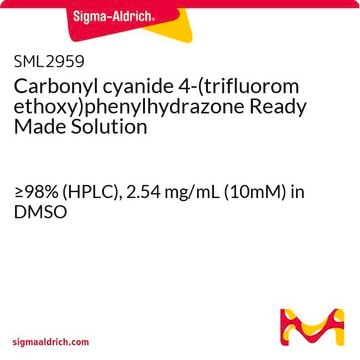C2920
Carbonylcyanid-4-(trifluormethoxy)phenylhydrazon
≥98% (TLC), powder, Mitophagy inducer
Synonym(e):
FCCP, Mesoxalonitril-4-trifluormethoxyphenylhydrazon
About This Item
Empfohlene Produkte
product name
Carbonylcyanid-4-(trifluormethoxy)phenylhydrazon, ≥98% (TLC), powder
Qualitätsniveau
Assay
≥98% (TLC)
Form
powder
Farbe
yellow
mp (Schmelzpunkt)
174-175 °C (dec.) (lit.)
Löslichkeit
95% ethanol: soluble
Lagertemp.
2-8°C
SMILES String
FC(F)(F)Oc1ccc(N\N=C(/C#N)C#N)cc1
InChI
1S/C10H5F3N4O/c11-10(12,13)18-9-3-1-7(2-4-9)16-17-8(5-14)6-15/h1-4,16H
InChIKey
BMZRVOVNUMQTIN-UHFFFAOYSA-N
Suchen Sie nach ähnlichen Produkten? Aufrufen Leitfaden zum Produktvergleich
Allgemeine Beschreibung
Anwendung
Signalwort
Danger
H-Sätze
Gefahreneinstufungen
Acute Tox. 4 Oral - Aquatic Chronic 4 - Eye Dam. 1 - Skin Corr. 1B - Skin Sens. 1
Lagerklassenschlüssel
6.1A - Combustible acute toxic Cat. 1 and 2 / very toxic hazardous materials
WGK
WGK 3
Flammpunkt (°F)
Not applicable
Flammpunkt (°C)
Not applicable
Persönliche Schutzausrüstung
Eyeshields, Faceshields, Gloves, type P2 (EN 143) respirator cartridges
Analysenzertifikate (COA)
Suchen Sie nach Analysenzertifikate (COA), indem Sie die Lot-/Chargennummer des Produkts eingeben. Lot- und Chargennummern sind auf dem Produktetikett hinter den Wörtern ‘Lot’ oder ‘Batch’ (Lot oder Charge) zu finden.
Besitzen Sie dieses Produkt bereits?
In der Dokumentenbibliothek finden Sie die Dokumentation zu den Produkten, die Sie kürzlich erworben haben.
Kunden haben sich ebenfalls angesehen
Artikel
DISCOVER Bioactive Small Molecules for Nitric Oxide & Cell Stress Research
Unser Team von Wissenschaftlern verfügt über Erfahrung in allen Forschungsbereichen einschließlich Life Science, Materialwissenschaften, chemischer Synthese, Chromatographie, Analytik und vielen mehr..
Setzen Sie sich mit dem technischen Dienst in Verbindung.












